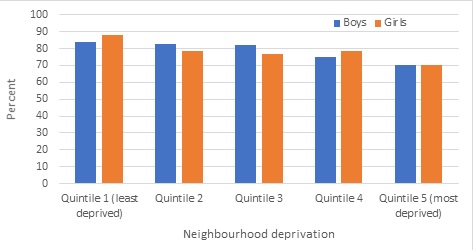Most people met recommendations for sleep duration
In 2020/21, seven out of 10 adults aged 15 years and over (69.1 percent) usually got the recommended amount of sleep in a 24-hour period. This figure was higher for children, with 78.3 percent of children (aged 0–14 years) meeting the sleep duration recommendations (see definition box below). There was no difference between males and females for either children or adults.
People living in more deprived areas were less likely to meet the sleep recommendations
Adults living in the most socioeconomically deprived areas were less likely to have met the sleep duration recommendations (62.4 percent) than those living in the least deprived areas (73.8 percent). The same pattern was seen in children, with 70.2 percent of those living in the most socioeconomically deprived areas and 85.9 percent of those living in the least deprived areas meeting the sleep duration recommendations.


Disabled people were less likely to have met the sleep recommendations
About half of disabled adults (49.6 percent) met the sleep recommendations, compared to 71.1 percent of non-disabled adults.
Learn more
- This data was taken from the 2020/21 New Zealand Health Survey Annual Data Explorer
- Tips for better sleeping are available on the Health Information and Services website
Definitions
For adults, 'Usually meets sleep duration recommendations' is defined for adults (aged 15+ years) as usually getting the recommended number of hours of sleep, including all naps and sleeps, for their age group in a 24-hour period.
Recommended hours of sleep are:
- Aged 15−17 years: 8 to 10 hours
- Aged 18−64 years: 7 to 9 hours
- Aged 65+ years: 7 to 8 hours
For children, 'Usually meets sleep duration recommendations' is defined for children (aged 0–14 years) as usually getting the recommended number of hours of sleep, including all naps and sleeps, for their age group in a 24-hour period.
Recommended hours of sleep are:
- Newborn (0–3 months): 14 to 17 hours
- Infant (4–11 months): 12 to 15 hours
- Toddler (1–2 years): 11 to 14 hours
- Preschool (3–4 years): 10 to 13 hours
- School age (5–13 years): 9 to 11 hours
- Teens (14 years): 8 to 10 hours
'Neighbourhood deprivation' refers to the New Zealand Index of Deprivation 2018 (NZDep2018). The NZDep2018 measures the level of relative socioeconomic deprivation for each neighbourhood according to a combination of the following: household income, benefit receipt, household crowding and quality (damp/mould), single-parent families, home ownership, employment status, qualifications, and access to the internet.
Results are output for quintiles of neighbourhood deprivation: quintile 1 represents the 20 percent of areas with the lowest levels of deprivation and quintile 5 represents the 20 percent of areas with the highest level of deprivation.
Disability status was measured using a set of questions called the Washington Group Short Set (WGSS). Disabled people are those who have a lot of difficulty with or can’t do the following at all: seeing or hearing (even with glasses or hearing aids), walking or climbing stairs, remembering or concentrating, self-care, or communicating. One of the limitations of the WGSS is that no question fully captures mental health impairments.
